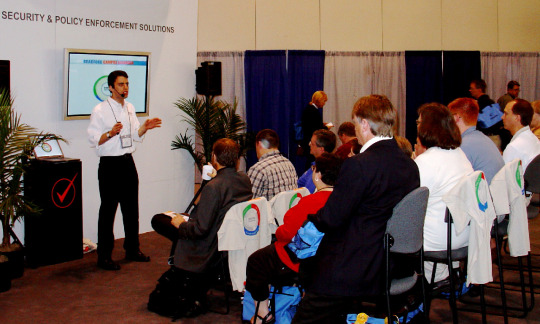
Congratulations! Your small
business is getting bigger, and your marketing director thinks it’s time to
rent a booth at the big upcoming trade show. Only one problem: You have no idea
how to present your products and services to their best advantage.
You are a perfect candidate
for Spark Presentations. This
web site lets you book a professional booth presenter. Or an MC. Or even a live
auctioneer. You can get trade show training for your booth staff, and
presentation skills training for your marketing people. Spark
Presentations is a one-stop site designed to make your trade show booths, sales
pitches, product launches and special events more effective and
enjoyable.
There’s
only one secret.
“I
created Spark Presentations to present a company that was larger than myself,”
says owner Andy Saks. “It’s like a house you can enter through any one of
a number of doors, each door representing a different service—but once you get
into that house you’re probably going to find me, providing most of these services.”
Sometimes
Saks will hire a colleague to do a booth staff training program, and he knows a
handful of people around the country who are ready to provide various trade
show services through Spark. But most of the high-end presenting and high-end
training—it’s just him.
Theater Geek
In 1998, the 28-year-old Saks
had been working a series of sales jobs in the Boston area—when he discovered
that he really enjoyed standing up and presenting products. Saks has always had
something of a theatrical inclination, and he enjoys working in front of an
audience. “That wasn’t the case with everyone,” he recalls. “Some
people were hesitant to stand up in front of customers and address them. I had
a theater background so I was comfortable.”
Saks, a self-described
“theater geek,” did sketch comedy at the University of Michigan and
improv in the Boston area, and he knew what it felt like to share a special
moment with an audience. “I didn’t want to be a sales person,” he
says, “but I didn’t want to be a starving artist either. I needed a way to
combine the sales part and the acting part.”
His brother Evan was in town
for a trade show, and when the siblings got together for dinner Evan said, “I
see these guys giving product presentations in these little booth theaters, and
I don’t think they work for the companies. You should investigate this.”
Saks spent the next day
wandering the show floor and finding these presenters. He’d pull each one aside
and ask, “How did you get into this? What do you have to know? What
equipment do you need?” Everyone was friendly and welcoming, and Saks
thought, “Hey, this could be it.”

The Biggest Start-Up
Challenge
Still, breaking into the
presentation business, even with Spark to provide a front, was no cakewalk.
“You don’t know
anything,” Saks laughs, “and you don’t know what you don’t know. You
have to brand yourself so you need a logo, and a business card, and an 800 number.
You don’t have
any contacts, you’re trying to find your footing, and it’s tough to keep
yourself motivated when you’re not sure what to do next.”
The
biggest start-up challenge for Saks was…starting up.
“It
took forever—almost five months—to get my first gig,” he says. “I
made business cards, I did head shots, I
created a demo reel from scratch—even though I didn’t actually have any footage
from a trade show booth. I learned how to use a tool called an Earprompter—the ‘Actor’s
Secret’—that
lets you record and play back a script so you don’t have to memorize it. Then I
registered with a bunch of talent agents who booked trade show presenters.
And…nothing.”
Finally
he called one of his agents and said, ‘Hey, I’m ready to go. What’s up?’
“So
this agent said, ‘Well, we have a trade show coming up in Chicago, but it’s not
a presenter position. We’re looking for someone to work the information counter.
We won’t pay your airfare, but if you can get here…’”
Saks
took the gig. He stayed with a friend, and spent eight days working the
information counter. Then, a few days after he got home that agency called him
and offered him a presenter role in New York. It was his first presenter
booking.
One
day, in between presentations, he found himself having a casual chat with a
client’s sales manager. The manager was complaining that his sales team didn’t
have the same skill set Saks demonstrated in the booth. And just off the top of
his head, Saks said, “Oh, well, I give presentation skills training too.”
The sales manager booked him on the spot—and in that moment Saks became a
presentations skills trainer.
He
was on his way.

Presentation Playbook
It
didn’t take long for Spark to get into the black—less than a year from the date
Saks borrowed money to start the company. It was the dotcom boom; there was
lots of work, and lots of money too. But when the dotcoms crashed in 2001,
maintaining profitability became a real challenge.
“I’ve
ridden these waves for the last 16 or 17 years,” says Saks. “There
have been times I’ve been very busy; and there have been times, like the
recession of 2009, when all of my clients disappeared. I had to reinvent myself
and find new clients and figure out how to reconnect with the world.”
So
he wrote a book. The Presentation Playbook.
Saks
could boast years of hands-on experience doing professional speaking, and he
had learned what worked and what didn’t. Now it was time to share.
“The
book is a calling card for the business,” he explains. “If you read
the book and like what I say, you are pre-sold on working with me. Sending copies
to prospective customers before a booking helps cement my authority, and makes
hiring me seem safer. ‘This guy wrote a book, he must know what he’s talking
about.’”
But
the book isn’t Spark’s only marketing strategy. Saks has accounts with
LinkedIn, Facebook and Twitter, but his most important marketing tool is his
web site.
“I
post blogs,” he says, “I update pages, and I work on search engine
optimization to make sure I’m drawing as much attention as I can. The other
thing I do is put out a monthly e-newsletter, marketing to people I already
know. I can tell them a bit about what I’m up to, what events are coming up, a
couple of presentation tips… It’s a great way to stay in contact with people without
bothering them every day.”
Universal Need
Looking to the future, Saks
sees trade
show training as his highest priority. It’s already the fastest growing part of
his business. “I believe there’s a massive market for this,” he says,
“and an almost universal need. So the challenge is: How do I expand this
training? How do I make more people aware of it?”
Saks
has just completed the first webinar version of his training. Since there are
many companies that can’t afford to book him in person, a webinar version allows
them to get the message at a reduced price.
“For
me,” he says, “all of this is fixed on one simple idea: helping an
organization thrive by making their message more compelling, and getting it out
to more people. That’s at the core of any marketing that any company
does.”





